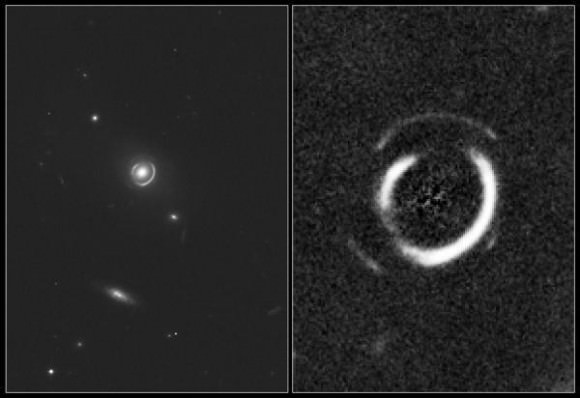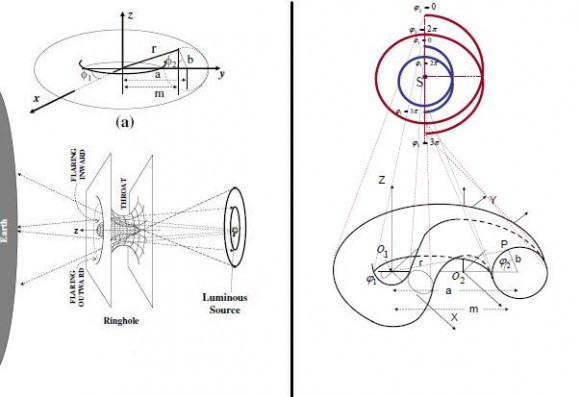Technology Review | The Physics arXiv Blog | KFC | 2011 Feb 25
Scientists investigate the possibility of wormholes between starsFar from being links between empty regions of space, wormholes could form shortcuts from one star to another
Wormholes are shortcuts in spacetime, throat-like links between otherwise distant parts of the Universe. There's no evidence that they exist but they do arise mathematically as stable solutions to the equations of relativity, just like other exotic objects such as black holes.
There's good evidence that black holes exist so astrophysicists can't simply dismiss the other solutions. In fact, they've devoted a good deal of time and effort to working out how wormholes might form, what they would look like and what might keep them open.
But in thinking about wormholes, they've tended to imagine them as empty tunnel-like superhighways between one region of empty space and another.
But Vladimir Dzhunushaliev at the Eurasian National University in Kazakhstan and a few pals have a different idea. They say there's no reason why wormholes can't be packed full of matter. And today they unveil the properties of such objects.
They begin by imagining an ordinary star or a neutron star with a wormhole at its heart. "For a distant observer, such a star would very much look like an ordinary star," they say.
However, there would be some important differences. For a start, this star would have to have a twin at the other end of the wormhole. These stars would be like Siamese twins, joined at the hip by the most bizarre of connections.
These twins would also pulse in an unusual way. That's because the exotic matter in the wormhole would be able to flow back and forth, like liquid in a u-tube, setting up a kind of resonance that makes the stars oscillate.
That could lead to the release of energy in all kinds of ways, creating ultra high energy cosmic rays, for example.
It also means there ought to be a way of distinguishing these Siamese twins from other stars. That's harder than it sounds, however.
The detailed calculations need to work out what oscillations are possible need to take account of the singularities that exist where wormholes are concerned. That makes them fiendishly difficult and certainly beyond Dzhunushaliev and co for the moment.
So they make no specific predictions about how astronomers could hunt down these objects.
That leaves an interesting puzzle for others to tackle. If stars can exist with wormholes at their centre, we'd obviously like to know what they look like so we can see whether there are any nearby. Time to get calculating.
PhysOrg | Astronomy | Lisa Zyga | 2011 Feb 25
A Star Harbouring a Wormhole at its Center - V Dzhunushaliev et alWormholes are one of the stranger objects that arise in general relativity. Although no experimental evidence for wormholes exists, scientists predict that they would appear to serve as shortcuts between one point of spacetime and another. Scientists usually imagine wormholes connecting regions of empty space, but now a new study suggests that wormholes might exist between distant stars. Instead of being empty tunnels, these wormholes would contain a perfect fluid that flows back and forth between the two stars, possibly giving them a detectable signature.
The scientists, Vladimir Dzhunushaliev at the Eurasian National University in Kazakhstan and coauthors, have posted their investigation of the possibility of wormholes between stars on arXiv.org.
The scientists began investigating the idea of wormholes between stars when they were researching what kinds of astrophysical objects could serve as entrances to wormholes. According to previous models, some of these objects could look similar to stars.
This idea led the scientists to wonder if wormholes might exist in otherwise ordinary stars and neutron stars. From a distance, these stars would look very much like normal stars (and normal neutron stars), but they might have a few differences that could be detectable.
To investigate these differences, the researchers developed a model of an ordinary star with a tunnel at the star’s center, through which matter could move. Two stars that share a wormhole would have a unique connection, since they are associated with the two mouths of the wormhole. Because exotic matter in the wormhole could flow like a fluid between the stars, both stars would likely pulse in an unusual way. This pulsing could lead to the release of various kinds of energy, such as ultrahigh-energy cosmic rays.
For now, the difficult part is calculating exactly what kinds of oscillations are occurring, and what kind of energy is being released. This information would allow scientists to predict what a wormhole-containing star might look like from Earth, and begin searching for these otherwise normal-looking stars.
- arXiv.org > astro-ph > arXiv:1102.4454 > 22 Feb 2011

